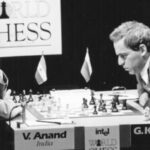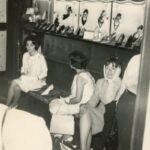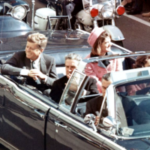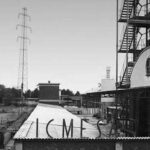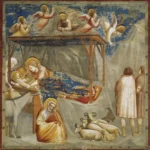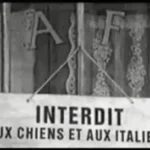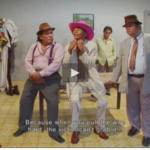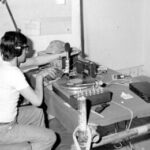November 27, 2024 Hidden history
“But do you really think that I do not know that I will end up like Kennedy ?”
“Aldo Moro, autumn 1977, La Sapienza University”.
Aldo Moro, his last 55 days. A revolution without the people
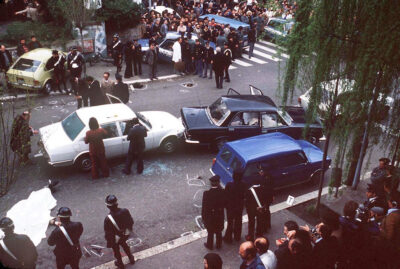
He was an ordinary man who, like every day, got up at dawn.
He was a florist by profession, and every day he stood at the corner of Via Fani and Via Stresa.
But on the morning of March 16, 1978, something went wrong and his life changed forever.
The night before, someone had slashed the four tires of the van he drove to work.
He was forced to stay home.
Had he been able to get to work by other means, he could have witnessed firsthand one of the most serious crimes in the history of republican Italy : the famous Via Fani massacre.
But that day in the capital, in many homes, people made a pact with their fate.
Among them was Oreste Leonardi.
Oreste Leonardi was 52 years old, from Turin, an instructor at the sabotage school of the Military Parachute Center in Viterbo and for 15 years the bodyguard of former Prime Minister Aldo Moro.
Like every day, he got up early, got coffee and took it to his wife.
Then, as he used to do, he went to meet the man he needed to escort.
That man was Aldo Moro, with whom he was a close friend.
Meanwhile, at Via Montalcini 8, a woman, Laura Braghetti, greeted some men who had sneaked out and prepared to listen nervously to the radio.
If the operation in which she was participating had a positive outcome, she would have been among the first to know.
The abductee will be taken to her place of residence.
The apartment has a cavity, a small one, in which a small cell has been built, with appropriate modifications, in which a cot, a small table and a chemical toilet have been placed.
On the wall was a five-pointed star that would become infamous.
Another man was getting ready to go to Via Fani.
He was one of the leaders, one of those who had meticulously prepared the plan for the ambush, along with the strategic direction.
His name was Franco Bonisoli, the man who, in front of the Church of Santa Chiara, where Moro went every day to hear Mass, had discovered that the Fiat 130 in which he was traveling was not armored.
Not being a weapons expert, he made sure for the umpteenth time that the gun he was going to use that day was loaded.
He had practiced for months in the countryside, in some caves.
Still, he did not feel ready on a practical level.
Meanwhile, eleven other people had left, each with a clearly defined task where no improvisation was possible.
Although there were many unknowns hanging over the destination.
Via Mario Fani, a few minutes after 8:30 a.m.
At the corner of Via Stresa, in front of the bus stop, two silhouettes in Alitalia uniforms can be seen.
At the same time, behind the hedge, four people are hiding with weapons in their fists, waiting to act.
On one side of the road, a white Fiat 128 with license plate CD19707 is parked.
On board is Mario Moretti, leader and head of the Red Brigades.
The anticipation of the group is cramped : someone, before going into action, “had to drink a cognac”, as the BR men will say in one of the trials of the Moro case.
I’m trying to imagine an alternative scene : let’s position ourselves inside the Fiat 130 going towards via Fani, coming down Via Trionfale.
At the wheel is Agent Domenico Ricci, next to him Oreste Leonardi, with his service pistol in a plastic bag.
Behind him, Aldo Moro is busy reading his notes : that day he is to present a government project, the first with the support, albeit only external, of the Italian Communist Party.
At his side are his inseparable bags, which are difficult to separate and which will later cause endless controversies because of their mysterious disappearance.
Ricci looks in the mirror.
He did so out of habit, always following the Alfetta driven by Giulio Rivera, with Brigadier Francesco Zizzi and guard Raffaele Iozzino on board.
It follows like a shadow on the Fiat 130, along the descent of Via Fani.
What happened next happened in an instant, and was patiently reconstructed, although there are still strong reservations.
From Via Stresa, a white Fiat 128 reverses, while from the side of Via Fani, the Fiat 130 with Aldo Moro suddenly slows down.
It was a moment, but Ricci did not brake in time.
The surprise was absolute ; the ambush had been organized in an extraordinary way.
The fiat 130 is blocked, for a few moments it seems that time has stopped : four armed men come out from behind the hedges of the Olivetti bar, part of the commando is already at work, blocking the traffic in all directions.
Ricci desperately tried to get out of the alley where he was trapped.
It is too late : a storm of lead hits the cars.
In the Fiat 128, Moretti shifts into reverse, making any maneuver impossible.
Almost simultaneously, Leonardi and Ricci fall under the storm of lead.
Iozzino doesn’t, he tries a desperate reaction, goes out with a gun in his fist, but is knocked down hard.
Someone hit him from behind.
Zizzi is not dead, but he is knocked out of the fight.
It only lasts a few minutes and everything is over.
Aldo Moro is thrown out of the car, with two Brigatists supporting him.
He is not injured, but this is discovered later.
Someone also took Moro’s bags.
The scene of the massacre is not only occupied by the Brigatists.
A little further down, engineer Marini arrived on his moped and had time to witness the scene, but only for a few seconds.
A Honda motorbike with two people on it fired a volley of machine guns at him, hitting the windshield of the moped.
The shock was so profound that Marini was unable to make a personal assessment of the dynamics of events.
Someone around him realized that something serious had happened.

It was shortly after 9 a.m.
A newsagent, whose shop was a few meters from the ambush, said that his son, attracted by the sound of gunfire, immediately ran to the scene of the massacre, just in time to have a gun pointed at his face.
Giuseppe Marrazzo, a Tg2 correspondent, interviewed a woman who witnessed the final stages of the ambush.
The woman stated that Moro was walking next to a young man, calmly, not excitedly ; that she clearly heard a woman’s voice ; that she heard a voice shouting “leave me” ; that Moro was loaded into a dark blue Fiat 128, which disappeared in the direction of Via Trionfale.
Let us return for a moment to the scene of the ambush and, with the help of a virtual camera, record the various scenes that follow one another in the eyes of hypothetical spectators.
Raffaele Iozzino is lying on the ground, the gun two steps away.
His face is lifeless, his gaze is fixed on the sky, his arms are outstretched.
He is only 25 years old, born in 1953 in Casola, in the province of Naples.
Domenico Ricci lies motionless, almost on top of Leonardi’s body.
He was 42 and had been Moro’s trusted driver for 20 years.
He was born in 1934 in San Paolo di Jesi.
Survived by a wife and two children.
At his side lies Oreste Leonardi, his face covered in blood.
He was born in Turin in 1926.
He is also survived by his wife and two children.
The fate of the other two escorts was different.
Francesco Zizzi, born in Fasano in 1948, team leader, dies while being transported to Gemelli Hospital in Rome.
Giulio Rivera, 24, born in 1954 in Guglionesi, in the province of Campobasso, dies instantly, shot eight times.
Five lives destroyed in a few seconds by what the newspapers will call “geometric firepower”, which fired at least 93 bullets, the casings of which were found at the scene of the massacre.
But there could have been more.
In fact, shortly afterwards, Tg1 correspondent Paolo Frajese arrives to document what happened.
We leave to his words, dramatic and broken in several places, the immediate account of what he saw.
A voice attributed to strong emotions, but actually due to the haste with which the reporter had arrived at the site of the ambush.
“Here is the car with the bodies of the agents who were part of Moro’s escort, covered by a tarp….
There are two men on the Fiat 130, another body is on the car that followed.The Carabinieri make the findings.
There are four dead and one wounded, a colleague tells me, and Mr. Moro has been kidnapped.It seems, this colleague tells me again, whom I thank, … it seems he was also wounded – look at the shots…. can you go to the door please ?
… look at the shots that were fired, apparently with machine guns, with machine guns, the body of another one of these — of these officers.Here on the ground again — let’s go over here to the right, please — the shell casings — you see, and then — again to the right — we see the bag, obviously Moro’s bag, and the cap of a… of a… you can’t tell what it is, it looks like a pilot’s — it would look like, no, a cap probably of a Police officer, it looks like maybe an Alitalia cap, but no, Alitalia doesn’t have those ranks… and the magazine of a machine gun.
Maybe the bombers were masked – maybe – in a strange uniform !
This is the scene.Another body here on the right…please come this way…I accidentally stepped on the grenades…here is the body of another, probably one of the escort members or maybe a bystander, we don’t know yet, the news obviously can only be gathered later.
Blood — blood on the ground, an automatic weapon, here — four bodies, four bodies — here, 10:00 a.m. on Via Fani. Four — on the ground.
Here is the document from this morning.We don’t know if there are eyewitnesses… Let’s try to look”.
At least 11 people participated in the ambush, plus the two on the Honda.
Their positions will never be fully clarified, but for all intents and purposes they are considered participants in the ambush.
They are Mario Moretti, Franco Bonisoli, Valerio Morucci, Barbara Balzerani, Raimondo Etro, Raffaele Fiore, Prospero Gallinari, Bruno Seghetti, Alvaro Lojacono, Alessio Casimirri and Rita Algranati.
The latter, at the time of the events, was the wife of Casimirri, the only one who escaped arrest.
The two on the Honda have never been identified, partly because their whereabouts were unknown for years : today we know that they were called “Peppe” and “Peppa”.
Digos is on their trail.
The battle is over.
As already mentioned, five lifeless bodies remain and the trail of Congressman Moro is lost.
And a pile of bullet casings.
They were fired from many guns, one of which fired 49 rounds and contributed significantly.
A specialist.
This strongly contradicts the version of the Brigatistas, who tend to downplay the military capacity of the group.
In the various stages of the trial, the presence of a professional killer, the one who allegedly fired the most shots, is repeatedly assumed.
An emblematic figure whose role varies depending on the point of view.
However, there will never be absolute certainty.
The weapons used are varied : a Smith & Wesson caliber 9 Parabellum (8 shots), a Beretta 52 caliber 7.65 (4 shots), a machine gun caliber 9 Parabellum, a Tz 45 (5 shots), a Beretta M12 (3 shots), an FNA or a Stern (49 shots).
As many as 45 shots hit the escorts ; Ricci, Rivera and Iozzino received the coup de grace.
Because on that day in Via Fani there was no escape : only physical elimination was planned, without mercy.
Years later, Sergio Zavoli interviewed several people connected to the events of Via Fani, reconstructing their dynamics and personalities.
Here are some excerpts.
Sergio Zavoli :
“Have you ever thought that you could be confronted, perhaps by your own choice, with the family member of a victim ? “
Franco Bonisoli :
“Yes, I thought … here, this is still a big problem of mine and I think it will remain with me … It is not only for this person, it is a little bit for all of them that I feel responsible, directly or indirectly.
Because, good or bad, it was such a strong experience, so totalizing, that even if I wasn’t there, I don’t feel less responsible than the person who was there….
This is a big problem that remains, and of course everyone can deal with themselves, with others, in a very personal way… and it is certainly more difficult for me.I think we don’t need the slogans here, the statements – I don’t know, principled…. Can you stop for a moment, please…. “
Sergio Zavoli :
“But what would you accept to be told by Eleonora Moro in a hypothetical meeting ?”
Mario Moretti:
“Everything, everything that she could possibly have to say… For me it can also be important, I don’t mind if the Moretti character is killed.
It’s a media character that I don’t care about at all, because the Moretti person, those who know me, know that it’s different.
Since I have no personalistic or political goals at the moment, I believe that I am in a position, like many comrades, of reflection, listening and careful observation of reality, rather than in the position of someone who has something to say about the trend of the world.So, with a very serene spirit, I could also speak to anyone who has suffered such pain as the loss of a person with whom they have lived for so many years with intense emotions…”.
Testimonies that strongly contradict the overall picture of what happened and cast even more doubt on who the real instigators of the massacre really were.
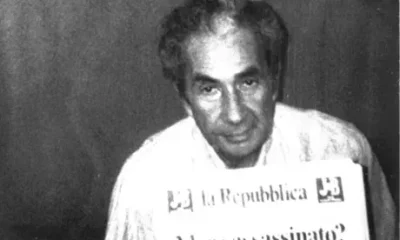
For 55 days, the country, the institutions and Mr. Moro’s family lived through a collective drama of false hopes and disillusionment.
But the final outcome of the kidnapping was essentially written from the moment of the ambush on Via Fani.
For the Red Brigades, the only logic is that of total confrontation : the five deaths caused by the terrorists cannot fail to affect any negotiations with the state.
And the state, its political class, reacts firmly, or at least with what immediately takes the form of a wall.
There can be no negotiations with the brigadists.
At the same time, the trade union confederations announced a general strike, with countless demonstrations against the brigatists and their massacre.
The country mobilized and the political class stood up.
The search was immediately difficult : the commando that had kidnapped Moro had planned the operation perfectly, or so it was believed at the time.
Immediately after the ambush, the three cars (the blue Fiat 128, the white Fiat 128 and the Fiat 130) reached Via Casale De Bustis, just after Via Massimi.
From that moment on, the reconstruction was entrusted exclusively to the Brigatti, who were later arrested.
Morucci will explain that in Piazza Madonna del Cenacolo a Citroën Dyane (Germano Maccari will say instead a Citroën Amy 8) and a van were waiting for the hostage, in which Moro was taken and then locked in a box.
From there he will reach his prison, at Via Montalcini 8.
Here he will be met by Anna Laura Braghetti, who will keep him prisoner until the day of his execution.
She had bought the apartment and registered it in her own name.
For 48 hours, the BR did not give any news : the wait was agonizing.
Then, on March 18, an anonymous phone call reached the journalist Maurizio Salticchioli.
A male voice warned him that there was a red envelope in Largo Argentina, near the underpass.
The journalist goes to the place without alerting the police and finds the envelope on top of a photocopier.
Inside was a Polaroid photo of Moro, along with five copies of “Communiqué No. 1”.
The photo shows Moro in his shirt, with the banner with the five-pointed star and the inscription “Red Brigades” behind him.
He is alive.
There is no doubt about it.
A face that seems serene despite his terrible experience.
An enigmatic, perhaps ironic smile lights up his face.
But also sadness.
Meanwhile, the cars used in the kidnapping and ambush were found on Via Licinio Calvo.
The driver of one of the cars was Franco Bonisoli, who would later explain :
“Soon after, the fire group broke up, each taking a different route.
I took the Fiat 128 to Via Licinio Calvio, where it was to be abandoned.I went down a flight of stairs … this street ends in a long flight of stairs.
I took a bus to Termini Station and from there I took the train to Milan”.
Meanwhile, in an atmosphere of great emotion, the funerals of the slain officers are held, while the police find the cars.
During this time, Moro is guarded by his jailers : Laura Braghetti, Mario Moretti (who conducts the interrogations), Prospero Gallinari and Germano Maccari.
From Laura Braghetti’s testimony, we now know that Moro lived his imprisonment with dignity, writing a lot and submitting to the strict rules of his jailers.
He responded calmly to interrogations and devoted his remaining time to writing letters to the outside world or to writing his memoirs, which were found in an incomplete form during a search in Milan, in Via Monte Nevoso, by the men of General Carlo Alberto Dalla Chiesa.
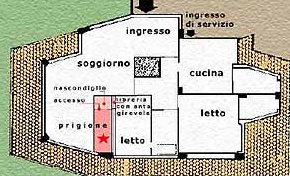
Meanwhile, the government has enacted new laws, the most important of which will have a decisive effect in the fight against terrorism.
This is the law that requires owners of apartments and buildings to report the names of tenants and buyers to the Public Security within 48 hours.
On March 29, two letters from Moro arrived : one addressed to his wife, Eleonora, and the other to the Minister of the Interior, Francesco Cossiga.
In these letters, Moro raised for the first time the possibility of a prisoner exchange for his release.
Moro’s mental state is discussed among politicians.
Many assume that the statesman is not very lucid, or even that he is now completely in the hands of his jailers, so that he has become a kind of puppet without a will of his own.
This is clearly a mistake : Moro is very lucid.
And he begins to exert more and more pressure, with his rigorous logic, warning that his death will bring no benefit to the country.
The trickle of communiqués from the brigatists also continues, based on statements in which they analyze the situation in the country in their usual terminology, according to an extremely partisan logic that has little to do with reality.
The wait became more and more agonizing.
On April 18 there was a turn.
In Via Gradoli, Mrs. Damiano called the fire brigade.
Water was leaking into her apartment from the apartment above.
The firemen arrived and immediately realized that something was wrong.
After a quick inspection, the fire chief decides to call the police.
The reason is that the apartment is a BR base.
At this point the most incredible thing happens.
The police show up, but not by stealth.
They arrive with sirens blaring, and a short time later there are as many people in Via Gradoli as there would be at an ordinary village fair.
The opportunity to search the hideout was lost.
Inside were weapons, explosives, fake IDs, air force uniforms, radios and the license plate of the Fiat 128 that hit Moro’s car.
What caused the infiltration was damage caused by the telephone shower, which was left open and facing the wall, causing water to seep from behind the bathtub along the wall.
A simple distraction ?
Or, more simply, did someone intend to bring down the BR base ?
But who ?
The answer is still uncertain.
Mario Moretti’s version that Barbara Balzerani wanted to distract does not hold up.
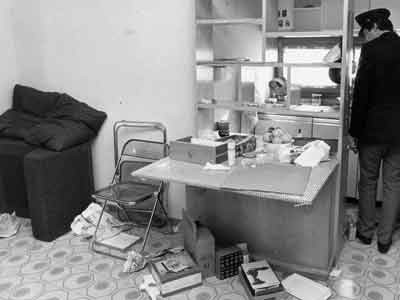
On the contrary, the more plausible hypothesis is that someone benefited from the kidnapping.
And that someone can only be an emanation of the Occult Directorate, which has wisely remained in the shadows since organizing the kidnapping.
The influence on the investigation of intelligence agents belonging to the secret Masonic Lodge of Propaganda 2, or P2 as it would later be called, whose lists would prove to be a mine of information that would cause an unprecedented political earthquake, is historically established.
Another noteworthy episode was the participation of Romano Prodi in a séance during which the “spirits” of La Pira and De Gasperi, using the well-known saucer system, revealed to those present that Moro “might” be a prisoner in Gradoli.
The investigators were informed of this and concentrated on investigating the town of Gradoli, forgetting the most obvious thing : to look in the street directory for Via Gradoli in Rome and not for the small town in the province.
Beyond this particular episode (probably a secret service agent passed on the information and, in order not to be discovered, resorted to the expedient of a séance), the investigation led to nothing.
April 18 is also a crucial date for another dramatic reason: an R.B. communiqué (No. 7) announces Moro’s death, a suicide, and indicates Lake Duchessa as the place to look for the body.
The search begins immediately.
The author is an inconvenient character, a member of the Magliana gang named Tony Chichiarelli, who is mysteriously murdered a few years later.
Another story with dark and elusive contours.
Meanwhile, meetings and appeals to find a solution multiply.
But nothing happened and Moro continued his desperate struggle from inside the “people’s prison”.
He wrote letters to everyone, from Zaccagnini to Andreotti, to President Leone and Cossiga, but also to his wife, the very sweet “Noretta”.
He remained tragically unheard.
So we come to April 30th, when at about 4:30 p.m. a phone call arrives at the Moro house :
“Listen, I am one of those who have something to do with your father.
I need to make one last announcement to you.We are making this phone call out of pure conscience, because your father insists that you have been a little misled, and you probably have a misunderstanding.
So far, you have all been doing things that serve absolutely no purpose.
Instead, we believe that the games have already been played and a decision has already been made.
All we can do in the next few hours is to carry out what we said in Communiqué No. 8.So we only believe that it is possible for Zaccagnini to intervene, immediately, and clarify in this sense; if this does not happen, realize that we will not be able to do anything but this.
Do you understand me ?
Did you understand me well ?”“Yes, I understand you very well”.
“Well, and only this is possible ; we simply did it out of scruples, in the sense that, you know, a death sentence is not something that can be taken so lightly even on our part.
We are willing to bear the responsibility that is ours, and we would like to do so precisely … since people believe that you did not intervene directly because you were misguided … ”“But we did what we could do, what they let us do, because they are really holding us captive…”
“No, the problem is political, so at this point the Democrazia Cristiana to intervene.
We have been very insistent on this because it is the only way to get to a negotiation at some point.If this does not happen, listen to me — look, I cannot discuss, I am not authorized to do so, I simply have to make this communication to you.
Only a direct, immediate, clarifying, precise intervention by Zaccagnini can change the situation ; we have already made the decision, in the next few hours the inevitable will happen, we cannot do otherwise.
I have nothing more to say to you”.
Mario Moretti spoke.
The situation now seems increasingly dramatic, and Moro returns to writing.
His letter to the DC is full of anguished consciousness.
He names the entire leadership group, no holds barred, and calls them corrupt.
He also writes a sad and dramatic letter to his lifelong companion, Eleonora.
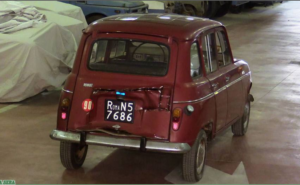
A spiritual testament.
The drama becomes an epilogue.
In the “people’s prison”, Moro is shaved and dressed.
He is told that he is about to be released.
They take him to the garage.
They make him sit in the trunk of a car.
Moretti covers him, then aims the Skorpion submachine gun and fires.
From close range.
The machine gun jams and he uses the gun.
The lifeless body lies in the red Renault 4.
The drama is over.
To throw off the investigation, the BR puts sand in the lapels of his trousers, covers the body with a tarp and takes the car and its gruesome cargo to Via Caetani, where it is found after a phone call by Morucci to the house of Professor Tritto, Moro’s friend.
“Hello, is this Professor Franco Tritto ?”
“Who is speaking ?”
“Dr. Nicolai”.
“Who, Nicolai ?”
“Is this Professor Franco Tritto ?”
“Yes, but I want to know who is speaking”.
“Red Brigades.
Do you understand ?”“Yes”.
“We are fulfilling the last wishes of the President by informing the family where they can find the body of Aldo Moro.
Do you understand ?”“What should I do ?
If you can repeat…”“I can’t repeate.
So you must tell the family that they will find the body of Aldo Moro in Via Caetani.
Via Caetani.There is a red Renault 4.
The first plates are N5”.
The coverage of this last part has been cut to the bone.
On purpose.
There is nothing more shocking than the death of a lone man, guilty only of being a pawn in a ruthless game.
Moro’s death, as I said at the beginning, is nevertheless a defeat for the Red Brigades.
Advocates of a revolution without the people, made to their detriment.
The five victims of Via Fani belonged to the people, even if they were identified as servants of power.
Just as the death of Moro, a man of dialogue, a pioneer of a new political system and an advocate of a more complete democracy, would be a blow to the Red Brigades.
Their geometric firepower, their ability to hold the state’s police apparatus in check, and their sense of invincibility would soon disappear.
One by one, the Brigatists who killed Moro and his companions would be captured and tried.
But the questions about the many oddities, the diversions, and even the many questions about the real course of history will not cease.
On the other hand, Italy has always been known for its mysterious and dark stories.


